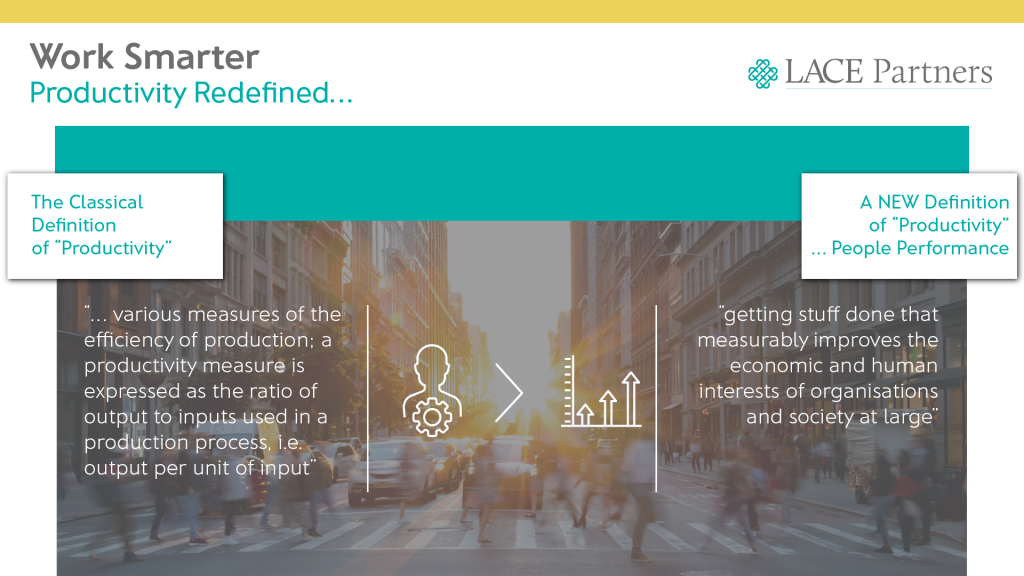Since the global pandemic and the fundamental shifts that have occurred in the world of work, emphasis has focused on how organisations can create value with what they already have, with one word being constantly re-iterated in the media and in boardrooms across all sectors:
Productivity.
The narrative that has been driven in the UK is that people productivity has been stagnant since the early 2010s. However, the pandemic saw rises in productivity as new ways of work emerged; hybrid working being one of the most well-documented, but the way in which leadership behaviours have helped to impact productivity have also been a factor (e.g. bringing your ‘full self’ to work, showing vulnerability, etc).
LACE Partners is creating this campaign – focused on redefining workforce productivity – to help businesses challenge themselves and ask a number of key questions.
We’re challenging businesses to look at what they mean when they talk about productivity and will be creating a series of thought provoking articles, podcasts, videos, as well as running events all focused around how businesses redefine the concept of workforce ‘productivity’.
Is the word ‘productivity’ right? A short history…
The word productivity first appeared in economic literature in 1766. According to David Sumanth the term productivity was probably first used by a French mathematician in an article on measuring inputs and outputs in a production process, in 1766.
This was at the dawn of the industrial revolution and was concerned with describing people working on farms and a few decades later was used to describe people working on farms and in factories. The word was used to describe and measure the rate at which people picked fruits and /or vegetables and latterly to describe workers producing widgets in a factory. By the early 20th century, nearly 80% of people worked on farms or in factories, and the classical definition of productivity was a very good description of what most people were doing at work (see Figure one below). Essentially that productivity is a family of ratios of output to input, which when measured correlates directly to living standards of the country (or regions) is measured by the goods and services produced by per unit of national resources.
‘Productivity’ in today’s world
However, fast forward to the end of the 20th century and the first two decades of the 21st century and the landscape of work looks completely different. Only about 20% of people work on farms or in factories, while nearly 80% work in offices doing “knowledge work”. We are far from producing widgets and spend most of our time using knowledge to come up with:
- New products
- New services
- New ways for doing things
- Managing projects
- Turning software and gadgets into intelligent servants of the workforce.
The classical definition of productivity is one dimensional mainly focused on measuring the value of turning raw materials into outputs, missing out on much of the “knowledge/innovation economy”.
Take for example Apple, the worlds’ first trillion-dollar market cap company (currently at $2.49trillion). The company does not manufacture or produce anything; they outsource their production to companies outside the US. Therefore, Apple is mainly an innovation and design company. Its market value is based on its track record of coming up with product ideas and designs for the consumer, often creating products that no one knew they wanted until they saw one (take for example, the first iPhones). They then create new versions of these products with ever enhanced features and functions (and often new designs of the existing product line). Its workforce does not take inputs and turn them into outputs in a factory setting, instead relying completely on the innovations thought up by their people.
Clearly the classical definition of “productivity” does not fit this modern company and requires a new definition to completely capture the value of what the organisation and its workforce “produces”. If we want to capture what many modern (and high value) companies do in the 21st century we have to look at (and measure) the full gamut of what they do that drives value.
So, what do we redefine ‘productivity’ as?
We have become dependent on a word that is no longer fit for purpose, perpetuating a misperception of what really drives value in the 21st century.
Nonetheless, if we use the word productivity (or performance, or other) it can be redefined to fit what we see in the global economy today (see Figure one below – from Tim Ringo in our team). Consider the following as one idea:
“Getting stuff done that measurably improves the economic and human interests of organisations and society at large”
A broader definition that focuses on the larger impact of workplace activity across not just the economic, but people, organisations and society. This comes closer to:
Figure one

If we break this down further to draw out the underlying elements of this expanded definition what was one-dimensional can become three-dimensional:
Figure two

Value: any redefinition of productivity still must have at its core, the fiscal side of inputs, outputs and the labour required to produce. This is how we keep score.
Engagement: when the people are aligned to the purpose, given the opportunity and tools required to learn new things, grow and flourish, something amazing happens; people have the headspace and the motivation to go above and beyond where the outcome is often, innovation.
Innovation: engaged workforces create new ways of doing things, new ideas for products and services and find ways to go beyond to serve customers.
More engagement leads to more innovation, which leads to more value and vice-versa, creating a virtuous circle.
Over the coming months we’ll be exploring workforce performance through a series of events, blogs, podcasts and videos. If you’d like to chat to us about workforce productivity in your business – whether across aspects like people experience or people and workforce analytics, we’d be happy to chat – just fill in the form below.






